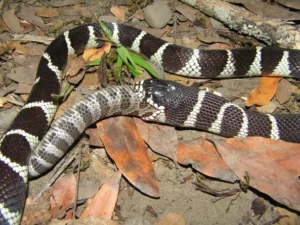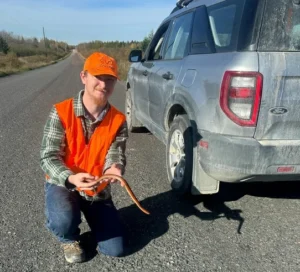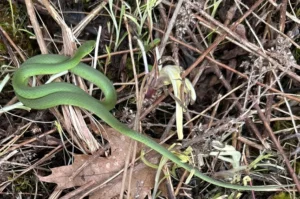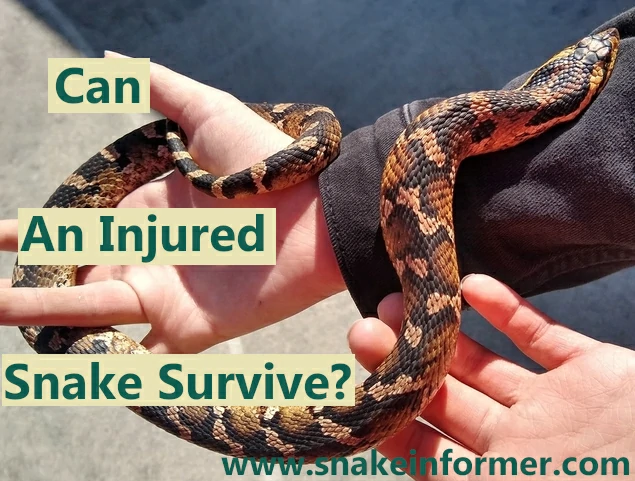Snakes in general are very adaptable creatures. They can change their lifestyle to best suit the type of habitat they are in.
An injured snake can survive if the injury is moderate and does not affect its internal organs or its ability to move and eat.
Snakes’ bodies have a remarkable ability to heal. They can regenerate damaged skin and scales, and close wounds.
In some cases, they can even recover from broken bones or lost tail tips.
What Type of Injuries Can a Snake Survive?
Understanding the type, and location of an injury is crucial when knowing if a snake has a good chance of survival.
Some injuries may heal on their own, while others need medical treatment or are even beyond recovery.
Below are the most common types of snake injuries, what causes them, and how serious they usually are.
1. Attack by Predators
Snakes are not always the top predators in their environment. They can also be prey for other animals.
Birds such as hawks, eagles, and owls, are some of their most dangerous enemies.
Mammals like mongooses, foxes, raccoons, and even domestic dogs can also attack snakes.
Surprisingly, other snakes can also be a threat. Species like king snakes are known to prey on other snakes, including venomous ones.

These encounters can result in serious injuries if the prey snake escapes after a failed attack.
Surviving such attacks depends on where the snake was injured, how severe the wounds are, and whether infection happens afterward.
For example, a snake that escaped with torn skin, but without internal injuries may survive and heal fine.
On the other hand, a snake with deep wounds, or broken bones may not survive long.
2. Cuts and Bruises
Snakes have protective scales, but they can still get hurt by their surroundings.
Cuts and scrapes can happen when a snake moves over sharp rocks, broken glass, or thorny plants.
This is most likely to happen in areas like gardens, farms, or construction sites.
These injuries may look like shallow scrapes, torn scales, or deeper cuts on the snake’s body.
They are usually not life-threatening, but they can become serious if bacteria enter the wound.
Snakes with minor cuts often heal on their own, especially if they can still move and hunt without any problems.
3. Burns
Snakes are ectothermic (cold-blooded), which means they depend on external heat sources to control their body temperature.
Burns can happen when snakes try to find warmth in dangerous places like exhaust pipes, engine compartments, or metal surfaces that have been in the sun.
This is fairly uncommon in the wild, but it can occur near human buildings or during accidental encounters with fire.
In severe cases, burns can turn into deep wounds, harming not just the outer scales but also the underlying muscle tissue.
Infections can develop quickly, especially if the burn is not treated right away.
However, minor burns are often not fatal, and the snake fully heals over a few weeks.
4. Tail Damage
Snakes sometimes lose their tails or damage their scales.
These injuries often happen due to encounters with predators, environmental dangers, or even accidental injuries.
For example, if a snake is attacked by a predator it might escape but could lose the tip of its tail or patches of its scales.
Accidents can also happen when snakes get caught in fencing, debris, or rocky areas.
Fortunately, injuries to the tail and scales are usually not fatal, especially if the snake’s vital organs, or spine are unharmed.
In general, many snakes survive and continue to live completely normal lives, even with tail or scale damage.
5. Being Run Over
Snakes often cross roads in search of food, mates, or warm surfaces to regulate their body temperature.
Asphalt and concrete hold heat, making roads an appealing spot for basking.
Unfortunately, this behavior places them directly in the path of moving vehicles.

When a snake is hit by a car, the injuries are sometimes just minor bruises.
However, in severe cases, a broken spine, and other internal damage.
Most often, severe injuries from being run over, are fatal for snakes. Especially if the vehicle runs over the snake’s body or head
Factors That Affect Snakes’ Ability to Recover From Injuries
Snakes can heal from injuries, but their healing abilities are limited and depend a lot on their surroundings.
Generally, healing works best for minor to moderate injuries, such as small cuts, burns, or small predator bites.
However, for severe injuries, like broken bones, deep infections, or internal damage, a snake’s chances of surviving drop significantly without professional medical help.
Here are a few factors that affect a snake’s ability to recover from injuries
Cleanliness of the Environment
A clean environment is crucial to prevent bacterial or fungal infections in open wounds.
Recovery relies on the snake’s exposure to dirt, parasites, or contaminated areas. Poor conditions can turn minor cuts into serious infections.
Proper Temperature Regulation
Snakes are ectothermic (cold-blooded) animals. This means they rely completely on their environment to regulate their body temperature.
Warmer conditions, within species-specific ranges, increase their metabolism. This allows for faster tissue repair, better immune responses, and shedding, which helps heal damaged skin.
If a snake gets too cold, the healing process can slow down significantly or even stop.
Feeding Ability
Injured snakes need to eat to provide their bodies with energy and nutrients.
If an injury affects important areas like the jaw, mouth, or digestive tract, the snake may not be able to eat.
This can eventually lead to starvation, organ failure, or a weakened immune system.
Stress Levels
Stress can significantly weaken a snake’s immune system and slow down healing.
A stressed snake may refuse to eat, have difficulty shedding, or become inactive. All of this can slow down recovery.
While healing, snakes need an environment where they are safe from predators and can relax without stress.
What to Do if You Find an Injured Snake
If you find a snake that appears injured, it’s a good idea to leave it alone.
Do not try to touch or interact with the snake in any way.
Handling a distressed snake with bare hands is risky. If you’re unsure about the species (venomous or non-venomous), do not try to touch or move it.

If you are sure the snake is non-venomous, you can gently guide it into a container for temporary holding.
Use a plastic storage bin, box, or bucket with a tight lid and ventilation holes.
Place a clean towel or soft cloth at the bottom to cushion and calm the snake.
Keep the container in a quiet, shaded, and temperature-stable location.
Once the snake is safely contained, call a local wildlife rehabilitation center, or a veterinarian.
As you wait for help, avoid giving the snake any ‘first aid’. It’s natural to want to help, but treating an injured snake without proper knowledge can cause more harm than good.
Conclusion
Many injured snakes can and do survive, especially under the right environmental conditions.
Snakes are remarkably resilient animals. Their slow metabolism, tough skin, and ability to go long periods without food help them endure injuries that could be fatal to other animals.
However, survival is not guaranteed. It mainly depends on the type and severity of the injury, and the conditions in which the snake experiences during recovery.
Sources:
Pleguezuelos, Juan & Feriche, mónica & Santos, Xavier. (2013). Tail-breakage effects on snake-body condition. Zoologischer Anzeiger – A Journal of Comparative Zoology. 252. 243–245. 10.1016/j.jcz.2012.06.004.
Guo S, Dipietro LA. Factors affecting wound healing. J Dent Res. 2010 Mar;89(3):219-29. doi: 10.1177/0022034509359125. Epub 2010 Feb 5. PMID: 20139336; PMCID: PMC2903966.
Christian LM, Graham JE, Padgett DA, Glaser R, Kiecolt-Glaser JK. Stress and wound healing. Neuroimmunomodulation. 2006;13(5-6):337-46. doi: 10.1159/000104862. Epub 2007 Aug 6. PMID: 17709956; PMCID: PMC2792763.
Hi, my name is Ezra Mushala, i have been interested animals all my life. I am the main author and editor here at snakeinformer.com.

